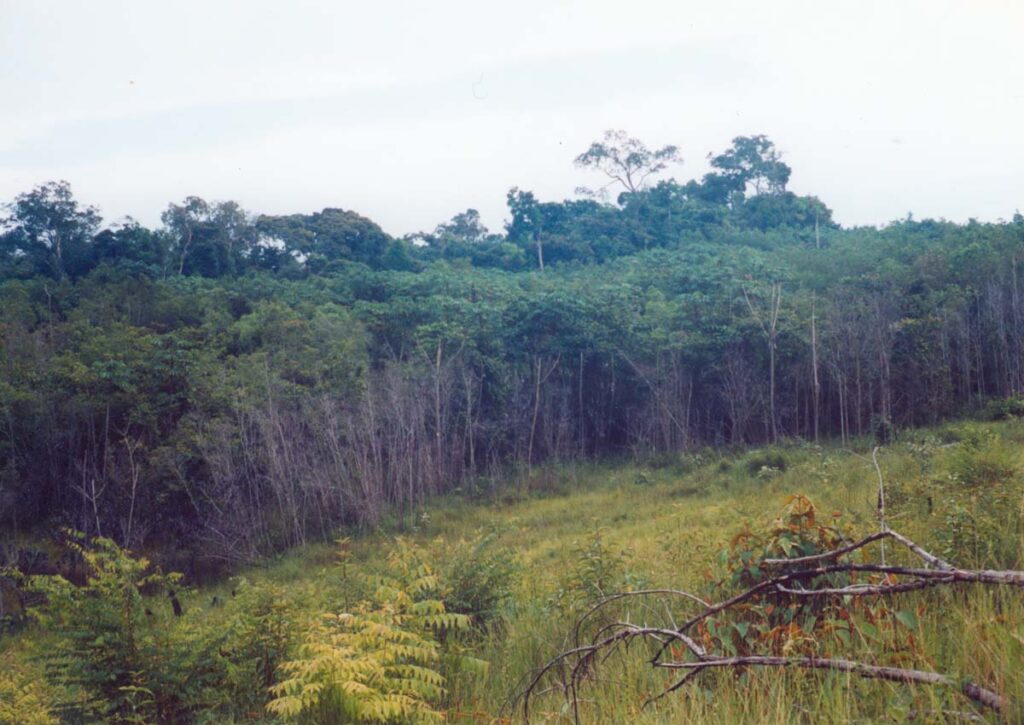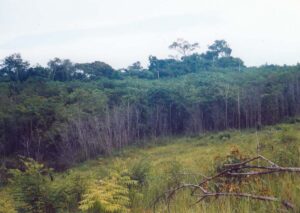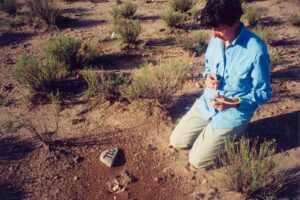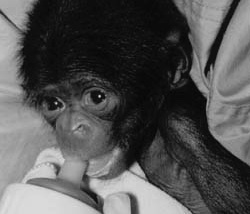What immediately strikes a newcomer upon entering the forest is how noisy it is, and how dark, beneath the canopy. Late last summer, I found myself standing in a preserve, a few hours drive from Manaus, Brazil in “continuous forest” which stretches for hundreds of miles to the Venezuela border. Leaves as big as your head rained down steadily, creating overlapping layers of brown, red, purple, and gray across the forest floor. A low roar from insects, including the leaf katydid, with its odd, bulbous mouth and spiky legs, built, pulselike, to periodic crescendos. Birds, including the scarlet macaw and yellow-ridged toucan, issued raspy calls. Marmosets and capuchin monkeys dropped detritus, cackling. The monkeys talked, bush dogs barked, wild pigs snuffled through the underbrush.

The preserve, called Dimona, is an outpost run jointly by INPA, the Brazilian government’s forest research institute, and the Smithsonian Institution. One in a string of study centers spread across the Amazon, the preserve is part of an effort to understand what happens when unbroken subtropical forest is riven by roads, logging and new settlements. To get there, I’d followed along with a group of biologists, specialists in the evolution of the fungus growing ants (the attines), ants which made the transition dozens of millions of years ago from a hunter-gatherer form of life to agriculture. The trip was successful as a scientific exploration of evolution in ants; the researchers made progress in tracking previously unstudied species which might help lay a trail between ants which hunt and those that farm. The expedition also provided a short course in the challenges confronted now by biologists concerned about preservation of the forest.
Facing west from the bluff where our outpost (two concrete slabs, a tin roof, and rows of hammocks) lay, you could catch the short course for this study in forest degradation: across clearings burned into existence years ago, a 250-acre stand of trees, raggedy at the edges, stretched across the ridgetop. Due east, behind us, through a gorge and past another clearing, lay a 2.5 acre fragment, then a 25-acre section before you reached the unbroken stands of tall trees we’d entered. In a way, this one spot summed up the experiment playing out all across the Amazon, an exercise by human beings in discovering how small a swatch of forest can shrink before it morphs into something else entirely.
“The question we confronted was this: how much do you have to preserve in order to maintain as many species as possible?” Heraldo Vasconcellos, director of the Biodiversity Dynamics of Forest Fragments Project, had explained in his office in Manaus a few days before we’d set off for Dimona. “We have different sizes of fragments and we’re looking at the diversity of species in each one.”
Since the day we arrived, I’d been curious to learn more about the project’s tree surveys, which generate much of the data scientists from around the world use to measure Amazon deforestation and its effects. If you have only a hazy picture of the general state of the Amazon, you might be forgiven for surprise that any of it is left, so dire were the predictions of its imminent demise in the late 1970s. Two thirds of it, containing half of the world’s total tropical rainforest, still stands, largely unscathed across 1.4 million square miles.
Antonio Tavares Mello, the leader of a trio of men doing the survey on the day I joined them, claimed that he’d just turned 60 although his lean athletic body belied his age. He’s been doing survey work for decades, helping to generate longitudinal data about the relative health of particular trees in precisely-demarcated sections of the jungle. Mello’s 30-year-old son, Antonio, Jr., and Juan Gabriel Soler, a Colombian who carried the chart where each patient’s symptoms were noted (color, signs of stress, condition of bark), followed him deep into the largest of Dimona’s forest fragments, the 250-acre stand just across from our camp.
Here the trees jockey to crowd each other out. Secondary growth is dense, the leaf litter often brittle and dry. Along the edges, where forest meets the clearing, wind whips through. It’s far quieter here than in the continuous forest, with less diversity of animal life. The men I was following weren’t looking for wildlife, though. They were assessing the health of the trees, examining fissures in the bark the way a doctor might contemplate a child’s complexion. Then they shimmied up 80 feet or more to snip samples of leaves for closer analysis back in the INPA laboratory in Manaus. Because their mission centers on keeping trees healthy, no spiked boots can be used. So the men simply wrapped leather straps around their boots, set their feet in a wedge, reaching up like sloths, and jumped up in long strides. They’re the largely unheralded heroes of forest conservation.

At one point, in suffocating heat, we spent nearly 20 minutes looking for Tree Number 936, crisscrossing a dense hillock. When we found it, Soler kicked the ground, pouting. The tree, still young, was a shell of its former self, hollowed out now by termites and overtaken as well by green and white lichen. “Es morte,” Soler said, crossing it off his list. Within small fragments of the forest like this one, tree mortality is far higher than in unbroken tracts. Fires are also more likely to break out here than in primary forest.
After pouring over reams of data generated in surveys like this one, two American biologists working at INPA headquarters on the outskirts of Manaus, Philip Fearnside and William Laurance, have estimated that about two percent of the Amazon is deforested each year. Laurance estimates that a third of it has been destroyed or seriously damaged, with the rate of destruction on the rise. In just one year, 1995, he found that a forest the size of Belgium disappeared.
Large cattle ranches are prime culprits in the losses. New roads built by a government intent on heightened agricultural production and economic development bring with them illegal logging, and settlers right behind on roads the loggers forge, creating what Laurance calls “a fishbone pattern of deforestation.” A new highway, which runs a few miles past Dimona, from Manaus clear to Caracas, is a visible example of the pattern. Loggers, many of them illegal poachers, have driven primitive roads through forest land. Colonists have followed the loggers, burning and slashing to create clearings for agriculture.
In the face of increasing Amazon deforestation, several scientists at INPA have called for a new approach in fighting to preserve it. Rita Mesquita, who runs a program for policy makers (lawyers, elected officials, economists, union leaders) on the INPA preserves, argues that “the wilderness model” favored in the United States, can’t be sustained. For one thing, population in the Amazon, including among indigenous people, is booming. Any plan for sustainable preservation needs to take people who live in the region into account, Mesquita said.
Mesquita is also critical of the World Bank for its one-sided view of economic development. An industrial boom in Manaus has ballooned the population to an estimated two million. On the outskirts of town, malnutrition among children runs as high as 45 percent and prostitution is on the rise. “People come here for development, that’s what they’re told, and shown on television, that they will find here,” Mesquita said. “But that’s not what they find, in fact. What’s development? That’s the number one issue.”
Mesquita advocates eliminating the kinds of subsidies for unsustainable development which international lenders provide — such as funding for roads and power plant projects — which she blames for drawing people into unfamiliar ways of life in urban centers. “The developers are generating a demand that does not exist until they create it. This model of development is disastrous. A lot of destruction is being done in the name of diminishing poverty,” Mesquita said.
Vasconcellos, a leading expert in biodiversity and one of Brazil’s premier ant specialists, is eager to expand scientific study in the region. As it turns out, ants are highly sensitive to changes in soil content, rainfall, and vegetation. This means that they could be useful as early warning signals of deteriorating environmental quality. Vasconcellos has already completed a series of surveys of ant populations across the Amazon, in studies which have demonstrated how foolhardy it is to expect that scattered preserves, no matter how large, will by themselves conserve the integrity of the forest.
“The distribution of species is not random,” Vasconcellos explained, stretching out a map of the region in his cramped offices in Manaus a few days before we set off for Dimona. “A lot of species have a microhabitat, which they need to survive. If by chance you have a big area lacking this particular microhabitat, you won’t provide for this particular species.”
Vasconcellos urges careful biological study. The ant surveys should be expanded, he argued, to show how protection of large, well-designed stands of protected forests, and provision of clear geographic links between them, can safeguard ecological integrity. “The truth is, we could learn so much from the ants,” Vasconcellos said, looking a bit surprised, himself, at the idea. “You can actually get a feeling of the global situation through sampling ants.”
The micro-habitats that Vasconcellos had mentioned, once bulldozed or burned out of existence, are difficult to restore. “The Amazon is at a crossroads now,” Laurance had told me over dinner in Manaus one evening. “In the next 20-40 years, 60 percent of what’s left could be deforested. Instead of the vast stretch of unbroken carpet, it might look more like a checkerboard.” A loose group of concerned scientists is now considering mounting an international campaign to save just half of the Amazon, for fear that otherwise it will, two percent at a time, simply slip away.
Deep inside the forest, watching a group of biologists collecting data, the idea that this forest could vanish seems preposterous. It’s roomy, noisy, full of cascading layers of life — the picture of biodiversity. But look at the degraded quality along the edges, and in the fragments, examine the data about desiccation and the rising frequency of fires. Watch, from the air, as unbroken green gives way to a network of farms, mining outposts, logging camps. Review the latest wildlife surveys, which suggest that extinction of species is on the rise. This overview creates a kind of dual vision, a warning imbedded inside this vivid portrait of the forest worth fighting to preserve.
My companions, loaded down with vials and other equipment, were looking down into the intricate channels and chambers which lie beneath the soil in colonies of fungus growing ants. It’s a hidden world of remarkable complexity only partially understood. Above them loomed trees shooting up 80 feet or more, intertwined monkey ladder vines hanging down. Lodged halfway up one of the trees was a stunning wild orchid, brilliant vermilion.
©2002 Douglas Foster
Douglas Foster is a freelance writer in Berkeley, CA studying animal behavior.



